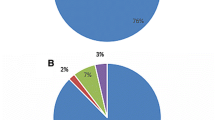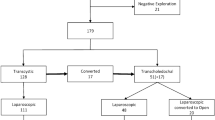Abstract
Background
The aim of this study was to assess laparoscopic treatment of choledocholithiasis with respect to the surgeon’s experience.
Methods
From January 1994 to December 2006, 130 patients underwent laparoscopic treatment for common bile duct stones found with intraoperative cholangiography. Two types of surgeons were defined: junior surgeons with fewer than ten laparoscopic common bile duct explorations performed and experienced surgeons with more than ten. The two patient populations (n = 65 in each group) were similar in regard to demographic data, clinical presentations (complicated or not), and ASA score.
Results
Results show that junior surgeons had significantly more patients with a common bile duct (CBD) diameter <7 mm compared to experienced surgeons (66 % vs. 38 %; p = 0.002). Primary closure of choledochotomy was performed by senior rather than junior surgeons significantly more often (87.5 % vs. 69 %; p = 0.05). Mean operating time was found to be longer for junior operators than for experienced surgeons (220 ± 71 min vs. 169 ± 71 min; p = 0.0006). There was no difference between group 1 (juniors) and group 2 (experienced surgeons) in regard to laparotomy conversion rate (9 % vs. 1.5 %; p = 0.1), complete common bile duct clearance (98 % vs. 100 %, p = ns), postoperative complications (two bile leaks in group 1 and one in group 2), and hospital stay (9 days vs. 7.5 days). In multivariate analysis, the transcystic approach was not influenced by the surgeon’s experience. Experienced surgeons performed choledochotomy with primary closure more easily [RR = 3 (range = 1.1–8); p = 0.04]. Complicated presentations [RR = 2 (0.7–3); p = 0.08] and CBD diameter [RR = 2.5 (0.96–7); p = 0.06] influenced the choice of type of closure of choledochotomy without any significant value.
Conclusion
Surgeon’s experience influenced operating time and type of choledochotomy closure performed but had no influence on postoperative results of the laparoscopic treatment of common bile duct stones.
Similar content being viewed by others
References
Kharbutli B, Velanovich V (2008) Management of preoperatively suspected choledocholithiasis: a decision analysis. J Gastrointest Surg 12(11):1973–1980
Collins C, Maguire D, Ireland A, Fitzgerald E, O’Sullivan GC (2004) A prospective study of common bile duct calculi in patients undergoing laparoscopic cholecystectomy: natural history of choledocholithiasis revisited. Ann Surg 239:28–33
Petelin JB (2003) Laparoscopic common bile duct exploration. Surg Endosc 17:1705–1715
Berthou JC, Drouard F, Charbonneau P, Moussalier K (1997) Evaluation of laparoscopic management of common bile duct stones in 220 patients. Surg Endosc 12:16–22
Millat B, Atger J, Deleuze A, Briandet H, Fingerhut A, Guillon F, Marrel E, De Seguin C, Soulier P (1997) Laparoscopic treatment for choledocholithiasis: a prospective evaluation in 247 consecutive unselected patients. Hepatogastroenterology 44(13):28–34
Hanif F, Ahmed Z, Samie MA, Nassar AH (2010) Laparoscopic transcystic bile duct exploration: the treatment of first choice for common bile duct stones. Surg Endosc 24(7):1552–1556
Leida Z, Ping B, Shuguang W, Yu H (2008) A randomized comparison of primary closure and T-tube drainage of the common bile duct after laparoscopic choledochotomy. Surg Endosc 22(7):1595–1600
Gurusamy KS, Samraj K (2007) Primary closure versus T-tube drainage after laparoscopic common bile duct exploration. Cochrane Database Syst Rev 24(1):CD005641
Martin IJ, Bailey IS, Rhodes M, O’Rourke N, Nathanson L, Fielding G (1998) Towards T-tube-free laparoscopic bile duct exploration: a methodologic evolution during 300 consecutive procedures. Ann Surg 228:29–34
Voitk AJ, Tsao SG, Ignatius S (2001) The tail of the learning curve for laparoscopic cholecystectomy. Am J Surg 182:250–253
Ludwig K, Lorenz D, Köckerling F (2002) Surgical strategies in the laparoscopic therapy of cholecystolithiasis and common bile duct stones. ANZ J Surg 72:547–552
Tutton MG, Pawa N, Arulampalam TH, Motson RW (2010) Training higher surgical trainees in laparoscopic common bile duct exploration. World J Surg 34(3):569–573
Bresadola V, Intini S, Terrosu G (2001) Intraoperative cholangiography in laparoscopic cholecystectomy during residency in general surgery. Surg Endosc 15:812–815
Shamiyeh A, Wayand W (2005) Current status of laparoscopic therapy of cholecystolithiasis and common bile duct stones. Dig Dis 23(2):119–126
Ebner S, Rechner J, Beller S, Erhart K, Riegler FM, Szinicz G (2004) Laparoscopic management of common bile duct stones. Surg Endosc 18:762–765
[No authors listed] (1998) Diagnosis and treatment of common bile duct stones (CBDS). Results of a consensus development conference. Scientific Committee of the European Association for Endoscopic Surgery (E.A.E.S). Surg Endosc 12(6):856–864
Lyass S, Phillips EH (2006) Laparoscopic transcystic duct common bile duct exploration. Surg Endosc 20(Suppl 2):S441–S445
Tokumura H, Umezawa A, Cao H, Sakamoto N, Imaoka Y, Ouchi A, Yamamoto K (2002) Laparoscopic management of common bile duct stones: transcystic approach and choledochotomy. J Hepatobiliary Pancreat Surg 9(2):206–212
Clayton ES, Connor S, Alexakis N, Leandros E (2006) Meta-analysis of endoscopy and surgery versus surgery alone for common bile duct stones with the gallbladder in situ. Br J Surg 93(10):1185–1191
Martin DJ, Vernon DR, Toouli J (2006) Surgical versus endoscopic treatment of bile duct stones. Cochrane Database Syst Rev 19:003327
Disclosures
Drs. Herrero, Philippe, Guillon, Millat, and Borie have no conflicts of interest or financial ties to disclose.
Author information
Authors and Affiliations
Corresponding author
Rights and permissions
About this article
Cite this article
Herrero, A., Philippe, C., Guillon, F. et al. Does the surgeon’s experience influence the outcome of laparoscopic treatment of common bile duct stones?. Surg Endosc 27, 176–180 (2013). https://doi.org/10.1007/s00464-012-2416-z
Received:
Accepted:
Published:
Issue Date:
DOI: https://doi.org/10.1007/s00464-012-2416-z




